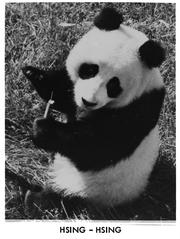Blogs across the Smithsonian will give an inside look at the Institution’s archival collections and practices during a month long blogathon in celebration of October’s American Archives Month. See additional posts from our other participating blogs, as well as related events and resources, on the Smithsonian’s Archives Month website.
In honor of October being American Archives month, the Smithsonian Institution Archives and Special Collections Council (SIASC) is hosting the third annual archives fair tomorrow, October 19th. The Archives Fair will include the ever popular "Ask the Smithsonian," as well as a series of lectures surrounding this year’s theme "Hidden Treasures." This year the Archives Fair will also include a brand new film festival, featuring collections from across the Smithsonian. As part of the film festival, the Smithsonian Institution Archives (SIA) will be debuting a film called "The Social and Reproductive Development of the Giant Panda" by Dr. Devra Kleiman. The pandas weren't just chosen because people love to watch them, they were chosen because of the significance of the scientific research surrounding the film's creation.
 Dr. Devra Kleiman was a biologist who worked at the National Zoological Park from 1972 until her retirement in 2001. She is best known for her research on Golden Lion Tamarins and Giant Pandas. Dr. Kleiman started studying the behavior of giant pandas at the zoo after two giant pandas, Ling-Ling and Hsing-Hsing, were presented by the Chinese government as a gift to the United States in 1972. Her research ultimately changed much of what scientists thought they knew about the social and reproductive development of the Giant Panda. When the pandas first arrived at the zoo, very little was known about them, but it was believed that they were solitary animals who only interacted during the mating season. Based on these understandings the pandas were kept in separate enclosures. However, by observing their behavior Kleiman discovered that pandas are actually social creatures. Consequently, the pandas were encouraged to interact more and Ling-Ling gave birth to five panda cubs (sadly, none of which lived more than a few days) during Kleiman's time at the zoo.
Dr. Devra Kleiman was a biologist who worked at the National Zoological Park from 1972 until her retirement in 2001. She is best known for her research on Golden Lion Tamarins and Giant Pandas. Dr. Kleiman started studying the behavior of giant pandas at the zoo after two giant pandas, Ling-Ling and Hsing-Hsing, were presented by the Chinese government as a gift to the United States in 1972. Her research ultimately changed much of what scientists thought they knew about the social and reproductive development of the Giant Panda. When the pandas first arrived at the zoo, very little was known about them, but it was believed that they were solitary animals who only interacted during the mating season. Based on these understandings the pandas were kept in separate enclosures. However, by observing their behavior Kleiman discovered that pandas are actually social creatures. Consequently, the pandas were encouraged to interact more and Ling-Ling gave birth to five panda cubs (sadly, none of which lived more than a few days) during Kleiman's time at the zoo.
The video the Archives will be showing at the film festival, "The Social and Reproductive Development of the Giant Panda," includes footage of the pandas from the early years of Dr. Kleiman’s research. In it, she discusses some of the challenges of getting the pandas to mate successfully. The film also includes several shots of the pandas at play with one another, which helped to further Dr. Kleiman’s assertion that pandas are not solitary creatures after all. The video is part of a larger collection of zoo footage that was recently digitized by the Archives. The importance of Dr. Kleiman’s research to the field of conservation caused this collection to be a priority for digitization, especially since all of her film is on rapidly deteriorating VHS tapes that are 20 to 40 years old.
This film is just one of six that will be featured at this year's film festival. Be sure to check out the Archives Fair 2012 website for the full list of film titles and descriptions. See you at the movies!
Related Collections
- Accession 01-227 - National Zoological Park, Dept. of Zoological Research, Animal Research Records, 1972-1990, Smithsonian Institution Archives
Related Resources
- Panda-monium!, The Bigger Picture Blog, Smithsonian Institution Archives
- Field Notes from a Battle Against Extinction, Field Book Project Blog, Smithsonian Institution Archives/National Museum of Natural History
- 2012 Archives Fair Schedule and Details
Produced by the Smithsonian Institution Archives. For copyright questions, please see the Terms of Use.

Leave a Comment